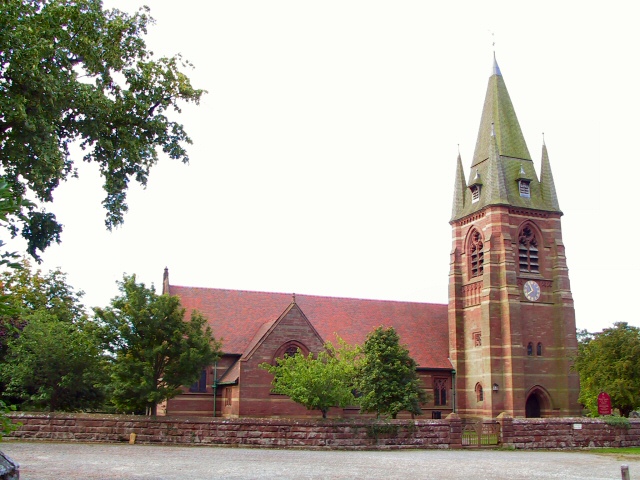Pulford on:
[Wikipedia]
[Google]
[Amazon]
Pulford is a village and former
 Pulford Castle, which no longer stands, was a small Norman
Pulford Castle, which no longer stands, was a small Norman
civil parish
In England, a civil parish is a type of administrative parish used for local government. It is a territorial designation which is the lowest tier of local government below districts and counties, or their combined form, the unitary authorit ...
, now in the parish of Poulton and Pulford, in the unitary authority of Cheshire West and Chester
Cheshire West and Chester is a unitary authority with borough status in the ceremonial county of Cheshire, England. It was established on 1 April 2009 as part of the 2009 local government changes, by virtue of an order under the Local Gover ...
and the ceremonial county of Cheshire
Cheshire ( ) is a ceremonial and historic county in North West England, bordered by Wales to the west, Merseyside and Greater Manchester to the north, Derbyshire to the east, and Staffordshire and Shropshire to the south. Cheshire's county tow ...
, England. It is on the B5445 road, to the south west of Chester
Chester is a cathedral city and the county town of Cheshire, England. It is located on the River Dee, close to the English–Welsh border. With a population of 79,645 in 2011,"2011 Census results: People and Population Profile: Chester Loca ...
and on the border with Wales. The civil parish, which included the hamlet
''The Tragedy of Hamlet, Prince of Denmark'', often shortened to ''Hamlet'' (), is a tragedy written by William Shakespeare sometime between 1599 and 1601. It is Shakespeare's longest play, with 29,551 words. Set in Denmark, the play depicts ...
of Cuckoo's Nest, was abolished in 2015 to form Poulton and Pulford.
According to the 2001 census, the population of the entire parish was 395,
increasing to 580 at the 2011 census.
History
The settlement was recorded in theDomesday Book
Domesday Book () – the Middle English spelling of "Doomsday Book" – is a manuscript record of the "Great Survey" of much of England and parts of Wales completed in 1086 by order of King William I, known as William the Conqueror. The manusc ...
of 1086, consisting of seven households across two separate landowners: Hugh FitzOsbern and St Weburgh Abbey, in Chester.
Pulford was previously a parish within Broxton Hundred, becoming a civil parish in 1866. The population was recorded over time at 170 in 1801, 204 in 1851, 305 in 1901, 285 in 1951 and increasing to 395 by 2001.
Landmarks
 Pulford Castle, which no longer stands, was a small Norman
Pulford Castle, which no longer stands, was a small Norman motte-and-bailey
A motte-and-bailey castle is a European fortification with a wooden or stone keep situated on a raised area of ground called a motte, accompanied by a walled courtyard, or bailey, surrounded by a protective ditch and palisade. Relatively easy t ...
defensive structure. Today, only the mound of the castle remains, just behind the church of St Mary, on the outskirts of the village. The castle remnants were designated a scheduled monument
In the United Kingdom, a scheduled monument is a nationally important archaeological site or historic building, given protection against unauthorised change.
The various pieces of legislation that legally protect heritage assets from damage and ...
in 1952.
The castle was built at a strategic location, protecting a road at a river crossing. Although no firm date of construction is recorded, it is believed to have been built around 1100.
The castle is mentioned as having a garrison
A garrison (from the French ''garnison'', itself from the verb ''garnir'', "to equip") is any body of troops stationed in a particular location, originally to guard it. The term now often applies to certain facilities that constitute a mili ...
stationed at it, during the revolt of Owain Glyndŵr
Owain ap Gruffydd (), commonly known as Owain Glyndŵr or Glyn Dŵr (, anglicised as Owen Glendower), was a Welsh leader, soldier and military commander who led a 15 year long Welsh War of Independence with the aim of ending English rule in Wa ...
in 1403.
Pulford Parish Church is dedicated to St. Mary and is designated a Grade II* listed building
In the United Kingdom, a listed building or listed structure is one that has been placed on one of the four statutory lists maintained by Historic England in England, Historic Environment Scotland in Scotland, in Wales, and the Northern I ...
. It was rebuilt in 1884 to a design by the architect John Douglas, the benefactor being Hugh Lupus Grosvenor, 1st Duke of Westminster. Mention of a church on the site can be traced back the 12th century and the first rector is mentioned in ancient records as one Hugo. The church's spire is 120 feet high. In the 1980s a fire completely destroyed the roof of the church tower, which was later restored.
The village is home to a large hotel, the Grosvenor Pulford Hotel. Grosvenor is the family name of the Duke of Westminster, whose seat is at nearby Eaton Hall.
See also
*Listed buildings in Pulford
Pulford is a former civil parish, now in the parish of Poulton and Pulford, in Cheshire West and Chester, England. It contains 15 buildings that are recorded in the National Heritage List for England as designated listed buildings. Of these, on ...
References
External links
{{authority control Villages in Cheshire Former civil parishes in Cheshire Cheshire West and Chester